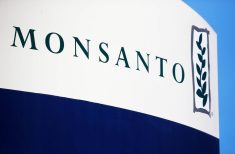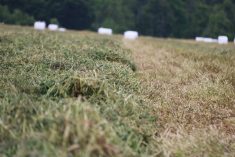The United States Department of Agriculture Economic Research Service recently published the results of a study into the economics of glyphosate-resistance management on U.S. corn and soybean farms. Through surveys and computer models it determined the relative costs of ignoring the problem versus taking action to address it. The following is an excerpt from that report. The full report can be found here.
Glyphosate — usually known by many trade names, including Roundup — has been the most widely used herbicide in the United States since 2001.
Read Also

Manitoba boosts stake in cereals centre to $23.5 million
Premier Wab Kinew said the additional project funds will help ‘Trump-proof’ the provincial economy.
It effectively controls many weed species, and generally costs less than the herbicides that it replaced. Because several major crop varieties have been genetically engineered to tolerate glyphosate, crop growers can spray entire fields planted to glyphosate-tolerant (GT) varieties, killing the weeds but not the crops.
This practice makes it easier to manage weeds using less tillage, which can help reduce soil erosion and improve soil quality and water conservation.
However, glyphosate’s effectiveness is declining as weed resistance mounts — 14 glyphosate-resistant (GR) weed species currently affect U.S. crop-production areas. GR weeds can reduce crop yields and increase weed-control costs, and recent surveys suggest that the amount of affected cropland is increasing. This study addresses several issues raised by the spread of GR weeds and the effect on U.S. agriculture.
What did the study find?
Reliance on glyphosate, by many growers, as the sole herbicide to control weeds is the primary factor underlying the evolution of GR weeds. Using glyphosate in isolation can select for glyphosate resistance by controlling susceptible weeds while allowing more resistant weeds to survive, which can then propagate and spread. Using herbicides with different modes of action, which affect susceptible weeds differently, and rotating their use over time can result in fewer herbicide-resistant weeds.
Growers report that glyphosate resistance is more prevalent in soybean production than in corn production. Since the commercial introduction of GT crops in 1996, glyphosate use in soybean production has promoted the spread of GR weeds more than its use in corn production.
In surveys of crop production practices, growers were asked to report their concerns about glyphosate resistance, either as the presence of “GR weeds” in corn or “declines in glyphosate effectiveness” in soybeans.
They reported GR weed infestations on 5.6 per cent of the corn acres in 2010 and declines in glyphosate effectiveness in about 40 per cent of soybean acres in 2012, with the majority of those acres in the Corn Belt and Northern Plains.
Soybean production relies more on glyphosate than does corn production. While more herbicide active ingredient was applied to corn than to soybeans, herbicides other than glyphosate accounted for most of the herbicide applied to corn acres.
In addition, tillage, which controls weeds without promoting herbicide resistance, was used on a greater share of corn than soybean acreage, whereas no till was used on a greater share of soybeans than corn acreage. Other findings show:
- Glyphosate-tolerant varieties were planted to more soybean than corn acres;
- Much more glyphosate (pounds of active ingredient) was applied to soybean than to cornfields;
- Glyphosate was used on more soybean than corn acres;
- Herbicide use practices were consistent with glyphosate-resistance management on fewer soybean acres (60 per cent) than on corn acres (82 per cent); and
- Glyphosate-resistance management was more likely to be done proactively on corn acres and more likely to be done reactively, in response to GR weeds, on soybean acres;
- Managing glyphosate resistance is more cost effective than ignoring resistance.
Choices
Simulation results over a 20-year period show that herbicide choices that help manage glyphosate resistance differ from short-term herbicide choices that ignore glyphosate resistance in three important ways.
Choices that manage resistance:
(1) use glyphosate during fewer years;
(2) often combine glyphosate with one or more alternative herbicides; and
As a result, glyphosate resistance is managed more cost effectively, and after about two consecutive years of managing resistance, the cumulative impact of the returns received exceeds that received when ignoring resistance.
Corn and soybean growers responded similarly to the reported presence of GR weeds or declines in glyphosate effectiveness.
The most common survey response — consistent with glyphosate-resistance management — was to use other herbicides in addition to glyphosate. Growers used this practice on over 84 per cent of corn acres with GR weeds and on 71 per cent of soybean acres with reduced glyphosate effectiveness.
The next most common response was to increase the amount of glyphosate used. Growers used this practice on 25 per cent of corn acres with GR weeds and 39 per cent of soybean acres with reduced glyphosate effectiveness.
Corn growers who reported GR weeds and soybean growers who reported reduced glyphosate effectiveness realized lower returns than similar corn and soybean growers who did not report them. In addition, corn and soybean growers who used glyphosate alone received lower yields and returns than similar corn and soybean growers who used at least one other herbicide in combination with glyphosate. Although the crop growers using more than one herbicide had higher production costs, the additional costs were more than offset by higher yields.
Economic incentives encourage co-operative use of resistance management practices (RMPs). Simulations show that weed seed dispersal from a field where crop growers ignore resistance when managing weeds could reduce the returns on nearby fields, and that the reduction could be larger for a nearby field where growers manage resistance than where they ignore it.
This result suggests that corn and soybean growers have an economic incentive to encourage neighbours to use RMPs and may also be aware of the incentive. Some soybean growers in Arkansas and North Carolina are responding to such incentives and collaborating in the management of herbicide-resistant weeds.















